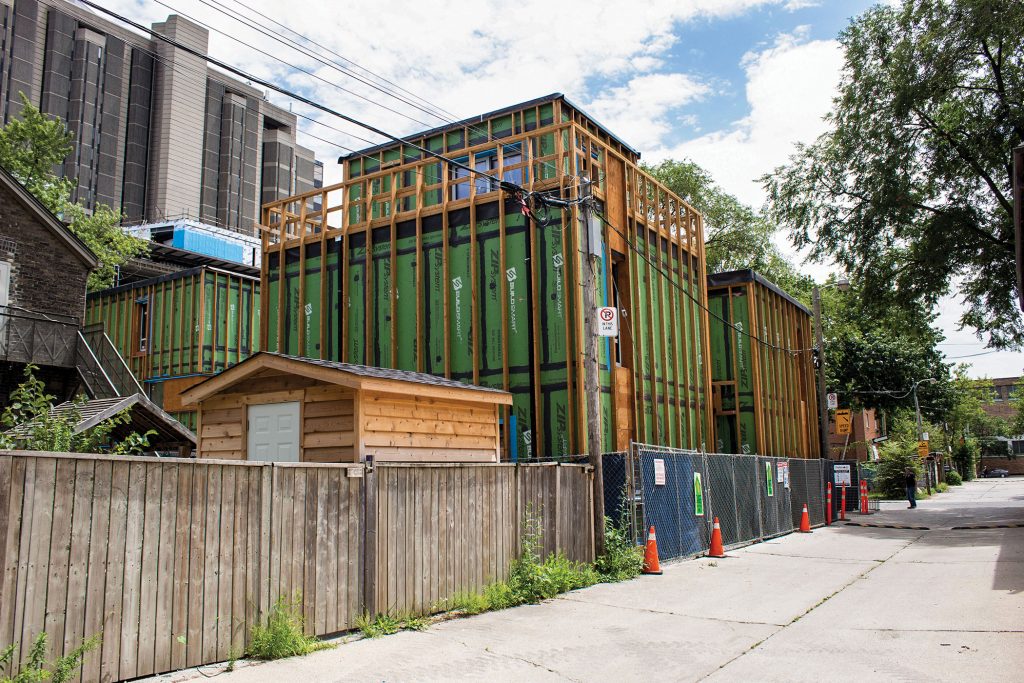Sustainable design was key to plan to build these and more

By Mary An
The making of University of Toronto’s pilot laneway homes located south of Sussex Avenue on Huron Street, is near completion. According to Anne Macdonald, Assistant Vice-President of Ancillary Services for the University of Toronto, they plan on getting residents for the laneway homes by this fall.
“It’s truly an experiment for us wanting to test out some ideas and see what was possible,” Macdonald said. These unique homes will be a first for the university, but not for Toronto.
Award-winning architect Brigitte Shim built her own laneway home more than 25 years ago. Shim is also a professor at the University of Toronto at John H. Daniels Faculty of Architecture, Landscape, and Design.
“We actually ran up against a lot of bureaucracy, because you couldn’t build a house behind a house, you couldn’t build a house without street frontage,” Shim said. Local planners at the time wondered about her quality of life because they thought it would negatively be affected by living in a laneway. After being approved to build in the laneway, and raising two kids in the home, Shim believes that laneway houses should be available all across Toronto.
“Everyone wants to live in the village, in the middle of the city, and laneways provide that opportunity. Our laneways are not just parking lots, but they actually become places for people to live,” Shim said.
According to thelanewayproject.ca, there are more than 2,400 laneways in Toronto. “You have all these downtown neighbourhoods, that need more people living in them. They’re not as dense as they could be, and laneway housing is one way to do that,” Shim said.
Understanding the need for density, the U of T launched a pilot laneway housing project. Teaming up with the Huron-Sussex Residents’ Association, they created a neighbourhood plan in 2014, identifying where development might occur. Six years later, the three pilot houses are almost finished, but, these are no ordinary laneway homes.
While planning these houses, the University of Toronto also considered their sustainability and energy performance.
“The goal is to be as energy efficient as possible. We were hoping for net zero, I don’t think we’ll be quite there but, we will be close,” Macdonald said. The homes will include solar panels to support this idea. It will also include a unique feature that was not originally predicted.
According to Macdonald, the three pilot homes will will be partially heated using geothermal energy. An ‘earth-tube’ will go down into the soil, where it will, “act as a moderating influence on air temperatures.” Earth-tubes were recommended by the architect of the project, as a sustainable alternative to fossil fuels because the earth is naturally warmer during winter, and cooler during summer. The integration of geothermal energy will allow for smaller, more efficient heating and cooling systems in the homes.
Earth-tubes would not have been possible if U of T hadn’t demolished a nearby house, leaving a big hole in the ground.
“It’s possible that future builds will not have that same opportunity,” Macdonald said, “but because we had it there we thought we would try it.”
Panel construction, which minimizes construction noise, is another unique feature of this development. According to Macdonald, finding a contractor who was comfortable with panel construction was, “tricky.”
“It’s essentially constructed of panels that kind of click together. They’re all pre-purchased, pre-assembled, and brought to the site…It all kind of snaps together as if it was a big Lego project, and then from there, the interior gets built,” Macdonald said.
The University of Toronto plans on building 30-40 more laneway homes after they receive feedback from the three pilot homes. According to Macdonald, it will take a year for feedback on the energy performance of the homes, and a few months for the design.
“We want them to make sense for families, because that’s who we house in the neighbourhood,” Macdonald said.
READ MORE:
- ON THE COVER: Laneway lit up (October 2018)
- CHATTER: U of T proposes laneway housing pilot on Huron Street (Spring 2018)
- ON THE COVER (JANUARY 2017): Putting the city’s laneways to work
- NEWS (JANUARY 2017): Laneway living
- NEWS (OCTOBER 2016): Preventing a wall of towers
